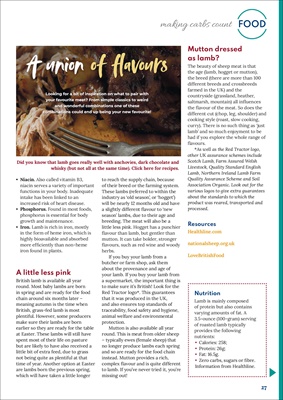
27
FOOD
making carbs count
• Niacin. Also called vitamin B3,
niacin serves a variety of important
functions in your body. Inadequate
intake has been linked to an
increased risk of heart disease.
• Phosphorus. Found in most foods,
phosphorus is essential for body
growth and maintenance.
• Iron. Lamb is rich in iron, mostly
in the form of heme iron, which is
highly bioavailable and absorbed
more efficiently than non-heme
iron found in plants.
A little less pink
British lamb is available all year
round. Most baby lambs are born
in spring and are ready for the food
chain around six months later -
meaning autumn is the time when
British, grass-fed lamb is most
plentiful. However, some producers
make sure their lambs are born
earlier so they are ready for the table
at Easter. These lambs will still have
spent most of their life on pasture
but are likely to have also received a
little bit of extra feed, due to grass
not being quite as plentiful at that
time of year. Another option at Easter
are lambs born the previous spring,
which will have taken a little longer
to reach the supply chain, because
of their breed or the farming system.
These lambs (referred to within the
industry as 'old season', or 'hogget')
will be nearly 12 months old and have
a slightly different flavour to 'new
season' lambs, due to their age and
breeding. The meat will also be a
little less pink. Hogget has a punchier
flavour than lamb, but gentler than
mutton. It can take bolder, stronger
flavours, such as red wine and woody
herbs.
If you buy your lamb from a
butcher or farm shop, ask them
about the provenance and age of
your lamb. If you buy your lamb from
a supermarket, the important thing is
to make sure it's British! Look for the
Red Tractor logo*. This guarantees
that it was produced in the UK,
and also ensures top standards of
traceability, food safety and hygiene,
animal welfare and environmental
protection.
Mutton is also available all year
round. This is meat from older sheep
- typically ewes (female sheep) that
no longer produce lambs each spring
and so are ready for the food chain
instead. Mutton provides a rich,
complex flavour and is quite different
to lamb. If you've never tried it, you're
missing out!
Mutton dressed
as lamb?
The beauty of sheep meat is that
the age (lamb, hogget or mutton),
the breed (there are more than 100
different breeds and crossbreeds
farmed in the UK) and the
countryside (grassland, heather,
saltmarsh, mountain) all influences
the flavour of the meat. So does the
different cut (chop, leg, shoulder) and
cooking style (roast, slow cooking,
curry). There is no such thing as 'just
lamb' and so much enjoyment to be
had if you explore the whole range of
flavours.
*As well as the Red Tractor logo,
other UK assurance schemes include
Scotch Lamb, Farm Assured Welsh
Livestock, Quality Standard English
Lamb, Northern Ireland Lamb Farm
Quality Assurance Scheme and Soil
Association Organic. Look out for the
various logos to give extra guarantees
about the standards to which the
product was reared, transported and
processed.
Resources
Healthline.com
nationalsheep.org.uk
LoveBritishFood
Britishwool.org
Nutrition
Lamb is mainly composed
of protein but also contains
varying amounts of fat. A
3.5-ounce (100-gram) serving
of roasted lamb typically
provides the following
nutrients:
• Calories: 258;
• Protein: 26g;
• Fat: 16.5g.
• Zero carbs, sugars or fibre.
Information from Healthline.
Did you know that lamb goes really well with anchovies, dark chocolate and
whisky (but not all at the same time). See here for recipes